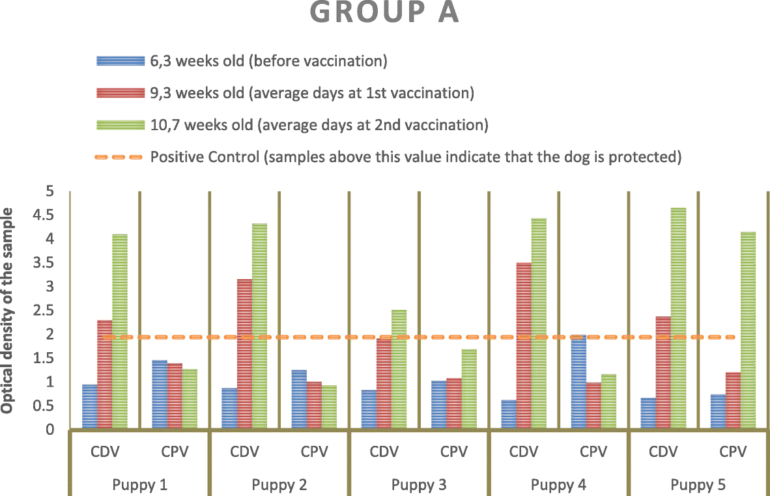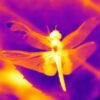In 1978, parvovirus—then common to cats—started infecting dogs in Europe. The virus spread quickly around the globe, killing hundreds of thousands of dogs, mostly puppies—until a team of Cornell researchers led by the late Leland “Skip” Carmichael developed a vaccine, the derivatives of which are still used today.
“It was really at the time a worldwide relief, a miracle,” said Colin Parrish, interim director of the Baker Institute for Animal Health, who joined Carmichael’s lab as a graduate student in 1980 and is now senior author of a new study that continues to advance our understandings of the virus and how the vaccine works.
The paper, published Feb. 14 in Proceedings of the National Academy of Sciences, shows how host antibodies bind to parvovirus and neutralize it. The findings shed light on fundamental interactions between viruses and their hosts, and open new doors for improving current vaccines and treatments for infected animals.
“This is an update on a very old story for us and for the institute, which is celebrating its 75th anniversary this year,” said Parrish, the John M. Olin Professor of Virology in the College of Veterinary Medicine. “As new technologies become available, we can apply them to understand old questions.”
Parrish has continued working on parvoviruses since first joining Carmichael’s lab, with more than 100 papers published on the virus family over the course of his career. He was elected to the National Academy of Sciences in 2023, and the study is the inaugural article showcasing his work. Oluwafemi Adu, a doctoral student in Parrish’s lab, and Hyunwook Lee, assistant research professor at the University of Minnesota’s Hormel Institute, are co-first authors.
This work builds on a previous study conducted with longtime collaborator Susan Hafenstein and her group, also at the University of Minnesota. The authors found that the number of antibodies produced after parvovirus infection in puppies is surprisingly small, with only two to three dominant antibodies.
“Immunologists or veterinarians would likely guess that there must be dozens or hundreds of different antibodies, but instead this work shows there are really only two or three,” Parrish said. “It sets a theme that others can follow up on, to see if this is a common feature of responses of animals—including humans—to viruses after infection.”
For the new study, Parrish and his team cloned the antibodies and used cryo-electron microscopy to determine their structures and interaction with the virus particle, showing where on the surface of the virus they bind. They found that all the antibodies block the receptors the virus uses to bind to host cells and spread infection but with varying efficacy, suggesting the evolution of an equilibrium whereby the virus evolves to survive while the host limits its damage.
The research opens new avenues for studying immune responses to viruses and has clinical implications for dogs. While the parvovirus vaccine can provide lifetime protection, it’s not perfect: Puppies can gain antibodies from their mothers that make the vaccine ineffective if given too early, which is why puppies require multiple rounds of vaccination to ensure protection. Dogs that do contract the virus may die of the disease, and survival often requires an expensive hospital stay.
Discover the latest in science, tech, and space with over 100,000 subscribers who rely on Phys.org for daily insights.
Sign up for our free newsletter and get updates on breakthroughs,
innovations, and research that matter—daily or weekly.
The antibodies Parrish’s group has identified could be used for therapeutic or diagnostic purposes, he said, and understanding the interaction between virus and host could lead to improved vaccines.
More broadly, the research continues the Baker Institute’s commitment to understanding and eradicating the diseases that plague dogs and their owners while also answering fundamental biological questions. This story started with James A. Baker, who founded the Institute in 1950—and who trained Carmichael, who trained Parrish.
“You have three generations of research on canine disease and a long history of interest in vaccines and immunity in dogs,” Parrish said. “This new work fits into the broader mission of the institute and shows that sustained research can pay off.”
Co-authors of the study include Simon Früh, Ph.D.; Marta V. Schoenle, postdoctoral researcher at the Baker Institute; Wendy S. Weichert, research support specialist; Andrew I. Flyak, assistant professor of microbiology and immunology (CVM); and Susan L. Hafenstein at the University of Minnesota.
More information:
Oluwafemi F. Adu et al, Structures and functions of the limited natural polyclonal antibody response to parvovirus infection, Proceedings of the National Academy of Sciences (2025). DOI: 10.1073/pnas.2423460122
Provided by
Cornell University
Citation:
Expanded understanding of how antibodies fight canine parvovirus may yield better vaccines (2025, February 18)



